Tags
Animal Migration, Bahía Magdalena, Baja California Sur, Children's Activities in Mexico, El Vizcaíno Biosphere Reserve, Festival de la Ballena Gris, Festivals in Mexico, Gray Whale, Gray Whale Festival, Laguna Ojo de Liebre, Laguna San Ignacio, Marine Mammals, The Whale Sanctuary of El Vizcaíno, UNESCO, Whale Watching, What's in Mexico
INFO
• 3–5 Feb (varies): Festival de la Ballena Gris (‘Gray Whale Festival’) – An annual festival at a small fishing port of Adolfo López Mateos – also other places like Puerto San Carlos – located in Bahía Magdalena (‘Magdalena Bay’) (State of Baja California Sur) (Link ‘Gray Whale Watching in Baja’). The festival includes various cultural events and ecotourism activities, but its speciality are whale watching tours. However, these expeditions also take place outside the timescale of the festival – as the peak season for whale watching is between January and early April.
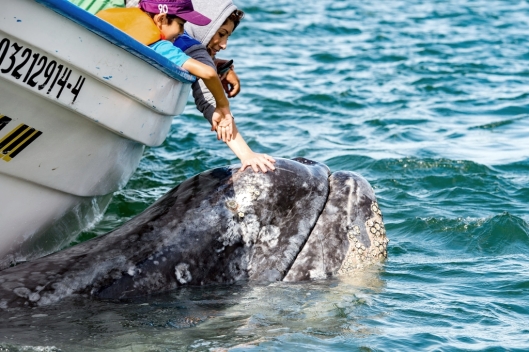
Children’s hands caressing and touching a mother gray whale (Eschrichtius robustus) and calf resting for milking, 5 Feb 2015, Adolfo López Mateos, Bahía Magdalena, Baja California Sur, Mexico / © Andrea Izzotti @ 123rf (ID 55335618)
Phenomenon: A Seasonal Migration of Gray Whale
Each year Mexico is the host of one of the most fascinating seasonal migratory phenomena – the gray whale (Eschrichtius robustus), also known as Pacific or California gray whale [for a full description, see NOAA Fisheries, Wild Whales, or The IUCN Red List]. The species is a large marine mammal that is part of the baleen whale suborder and belongs to the cetacean family, which also includes dolphins and porpoises.
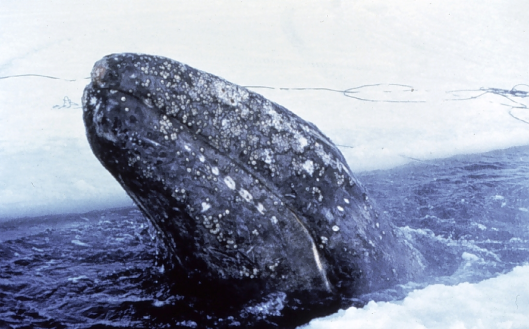
Gray whale (Eschrichtius robustus) trapped in the ice – a joint American-Russian effort ultimately saved 2 out of 3 trapped whales, Bering Sea, Alaska / NOAA: NOAA’s Ark – Animal Collection (ID theb3673)
Each October, a group of once endangered eastern Pacific population of gray whales start a two-to-three month-long journey (8000–11000 km or 5000–6800 mi) from summer feeding grounds of the cold and frozen Siberian and Alaskan waters of the Bering and Beaufort Seas, along the western coast of the Pacific Ocean, to winter breeding grounds – the warm and shallow lagoons and bays of Baja California Sur. Although larger aggregations may be seen in feeding and breeding grounds, the gray whale is a solitary marine mammal. It travels alone (or in pairs of mothers and calves, or even in small unstable groups) day and night – approx. 120 km (75 mi) per day at an average speed of 8 km/h (5 mi/h) [NOAA Fisheries].
The round trip (approx. 16000 km or 10000 mi) of the gray whale is believed to be the longest annual migration of any mammal.

Aerial view of a gray whale (Eschrichtius robustus) / NOAA: NOAA’s Ark – Animals Collection (ID anim0845)
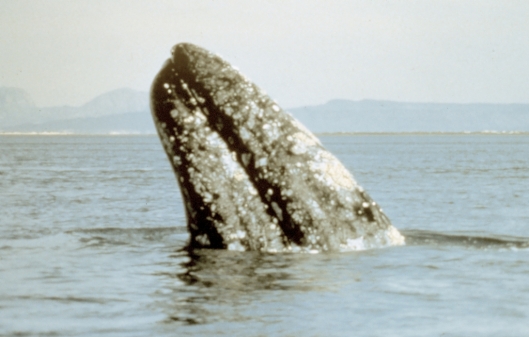
Gray whale (Eschrichtius robustus), Laguna Ojo de Liebre, Baja California Sur, Mexico / NOAA: NOAA’s Ark – Animal Collection (ID anim0846)
Bahía Magdalena: Winter Breeding Grounds
Bahía Magdalena – a 50km-long bay, protected by the white sandy barrier islands of Magdalena and Santa Margarita – is one of the three most popular winter breeding grounds. The other two – Laguna Ojo de Liebre (formerly known as ‘Scammon’s Lagoon’) and Laguna San Ignacio – are the most undeveloped nursery and breeding grounds in the world for the species, and are part of UNESCO World Heritage Site, namely The Whale Sanctuary of El Vizcaíno – a complex mosaic of wetlands, marshes, halophytes, dunes and desert habitats, as well as mangroves in the transition areas. The two lagoons are embedded in the much larger El Vizcaíno Biosphere Reserve, Mexico’s largest protected area as well as the largest wildlife refuge in Latin America.
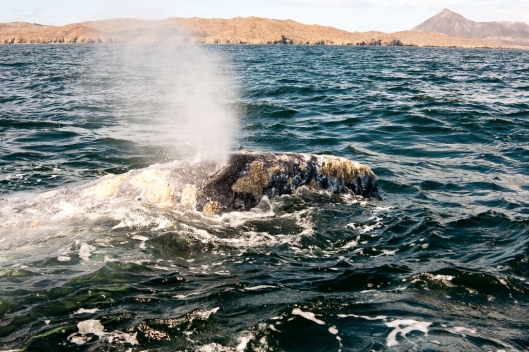
Gray whale (Eschrichtius robustus) blowing water, Bahía Magdalena, Baja California Sur, Mexico / © Sheldon So @ 123rf (ID 21089042)
All three places are sanctuaries providing perfect environmental conditions for winter breeding grounds, where gray whales are able to fulfill their biological cycle from the end of December to early April. After 12–13 months of gestation (a period of pregnancy, typically, for mammals), the first gray whales to arrive (mid-December to early January) are pregnant females, who give birth to a single calf in warm and shallow waters. They raise their calves for 2–3 months, and, if they are lucky, get pregnant again. These calves reach sexual maturity when 8 years old. Single females also arrive with these pregnant ones. By mid-February to mid-March, the bulk of the population has arrived in the lagoons, filling them with nursing, calving and mating gray whales.
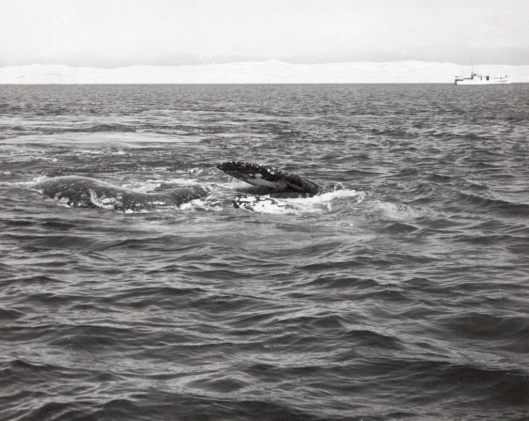
A historical photo of a pair of gray whales (Eschrichtius robustus) rolling and roiling at the surface preparatory to mating, with yacht Grayling in background, Laguna Ojo de Liebre, Baja California Sur, Mexico / Dr Raymond W Gilmore @ NOAA: NOAA’s Historic Fisheries Collection (ID fish5334)
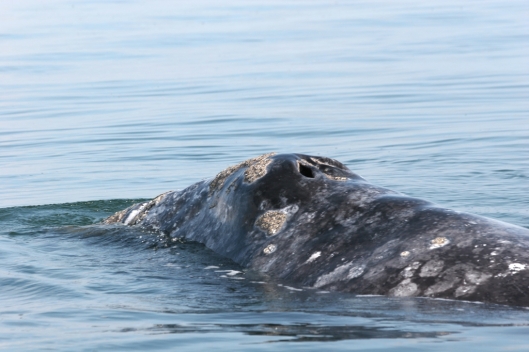
A mother gray whale (Eschrichtius robustus) / Dr Steven Swartz @ NOAA: NOAA’s Ark – Animal Collection (ID anim1725)
Throughout February and March, the first to leave the lagoons are males and females without new calves. Pregnant females and nursing mothers with their newborns are the last to depart, leaving only when their calves are ready for the journey back to their summer feeding grounds – usually from late March to mid-April. Often, a few mothers linger with their young calves well into May.
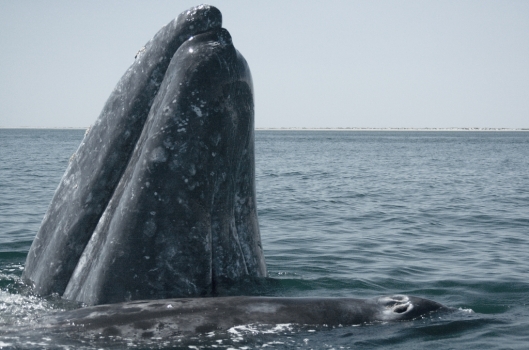
A mother gray whale (Eschrichtius robustus) with its calf spyhooping, as being approach by tourists, Baja California Sur, Mexico / José Eugenio Gómez Rodríguez @ Wikipedia
Activity: Whale watching
Whale watching expeditions provide eco tourists, including those travelling with children, as well as marine mammal enthusiasts with the opportunity to see and appreciate groups of gray whales as they migrate, as well as offer them up close encounters with the species in its natural environment.
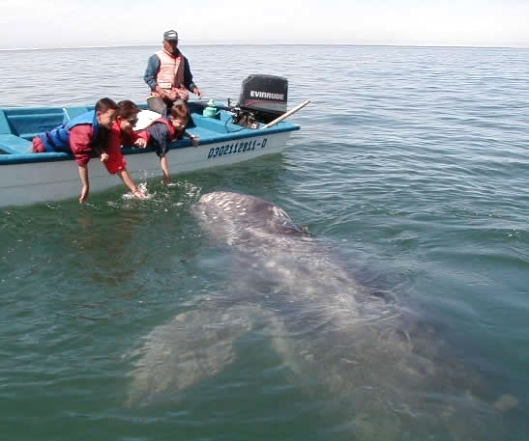
Whale watching on a boat with children attracting the attention of a gray whale, Laguna San Ignacio, Baja California Sur, Mexico / Jorge Peon @ Wikipedia
According to the law, these expeditions need to be led by an authorised guide as tourism in the past caused a threat to the existence of gray whales. Official guides, therefore, must pass a course in protection and observation of the species, while vessels must also pass a passenger safety inspection [Thomas, in Baja Insider]. It must be observed that ecotourism and whale watching cannot be an exception to current threats – i.e. disturbance by boats [NOAA Fisheries]!
Due to the over-exploitation of marine life (including sea turtle and shark poaching) [for the exploitation and slaughtering industry of gray whales in the past, see Thomas, in Baja Insider], Costasalvaje (WILDCOAST) began its coastal and marine conservation efforts in 2010, as well as promotion of ecotourism activities in the area. If you are looking for the best experience, recommended whale watching eco tours are as follows: at Bahía Magdalena by Bahía Magdalena Whales; at Laguna Ojo de Liebre by Gray Whale; and at Laguna San Ignacio by Oceanic Society and Baja Discovery.
Gray whales – once called ‘Devil Fish’ as they expressed their violent reactions due to harpooning by whalers [NOAA Fisheries] – have now become known as ‘Friendly Whales’ as they love swimming right up to the boats. They even allow human contact – they are extremely soft to touch [Thomas, in Baja Insider]. As nursing mothers travel back with their young without the presence of males, mothers are less protective and often allow their young to approach boats more freely [Thomas, in Baja Insider].
Identifying the species: the Gray Whale
Some species of the whales, such as the killer whale, are large, distinctive and easy to identify. Other species, however, are more difficult to distinguish, and observers should rely on clues such as colour and body shape, behaviours and group size to determine which species were seen. The first indication that you have spotted the gray whale is a blow, flukes or splash.
Below are some of the key things to look out for when observing the gray whale, but, as it is likely that other cetaceans can also be seen in the wild during the whale watching tours, one can study photos ahead of the trip, published in a very useful article, accompanied by a printable guide, by Wild Whales.
1. By Physical Appearance: size, colour and Body Shape
In terms of SIZE, gray whales measure from 4.5–5 m (14–16 ft) in length for newborn calves to 13–15 m (43–49 ft) for adults – females are slightly larger than males. An adult can weigh more than 35000 kg (80000 lb), while a newborn about 920 kg (2000 lb) – but as a newborn is ‘born to be BIG’, calves may gain 27–32 kg (60–70 lb) each day on their mother’s fat-rich milk [North Journey].
The gray whale is about the same size as 10 large elephants. [North Journey]
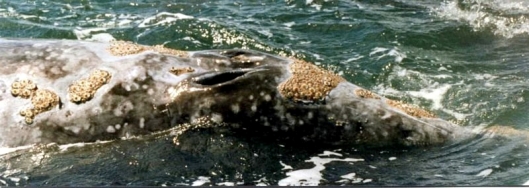
A close-up of two blowholes of a gray whale (Eschrichtius robustus) and some of its encrusted barnacles, San Ignacio Lagoon, Baja California Sur, Mexico / Phil Konstantin @ Wikipedia
In terms of COLOUR, an adult can be recognised by grey and white mottling patterns on its dark greyish slate skin, while a young has a darker grey to black skin. The patterns are scars or patches left by skin parasites – barnacles and whale lice –, causing the skin look discoloured and giving the mammal the appearance of ‘crusty ocean rock’ [Whale Facts]. The parasites either drop off when the gray whale is in its cold feeding grounds or are still attached. While most of the body is covered with them – with a higher concentration on the head, around the blowholes and its tail – there are little or no parasites on its right side because of the way the gray whale scrapes its body along the ocean bottom to feed.
Gray whales provide a home for more barnacles than any other species. [Keith E Jones, in Gray Whale]
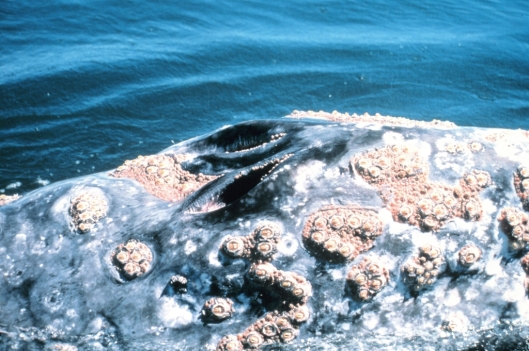
A close-up of two blowholes of a gray whale (Eschrichtius robustus) showing large assemblage of barnacles, Gulf of the Farallones NMS, California, USA / Jan Roletto @ NOAA: NOAA’s Sanctuaries Collection (sanc0118)
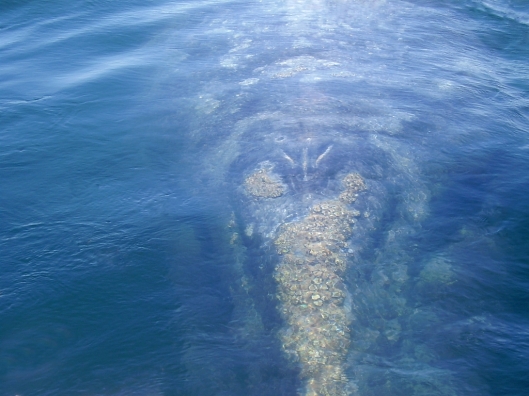
Gray whale (Eschrichtius robustus) approaching scientists’ boat and showing barnacles on the head / Dr Steven Swartz @ NOAA: NOAA’s Ark – Animal Collection (ID anim1730)
In terms of BODY SHAPE, the gray whale has a streamlined body and a narrow head. It has small eyes, about the size of a baseball. When it opens its curved and long mouth, one can observe that, instead of teeth across the upper jaw, it has cream baleen plates with bristles (about 160 pairs) that serve as its filter-feeder system. The tongue can weigh up to 1300 kg (1000-3000 lb). Like all baleen whales, the gray whale – a seasonal, carnivore and bottom feeder – sieves through the mud on the bottom of the ocean floor of the Arctic. In other words, when the mammal takes ocean water into its mouth and then pushes it out, the baleen plates help to filter animals (such as krill, squid and fish) that remain as food source for the whale. The gray whale uses only one side of its baleen, as it usually feeds on its right side. During migration and while in winter breeding grounds, gray whales eat very little. They live off their thick layer of blubber (fat) – c. 25 cm (10 in) thick – which also keeps them warm in cold waters.
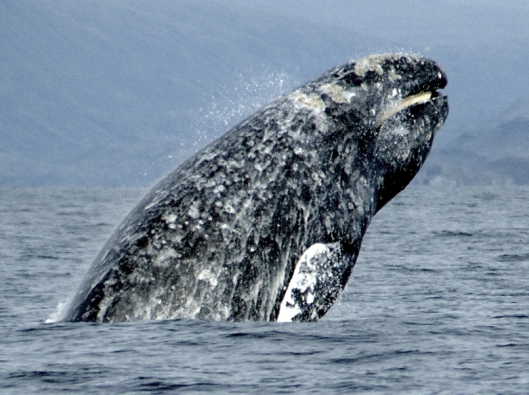
Gray whale (Eschrichtius robustus) breaching while showing its baleen / Merill Gosho @ NOAA: NOAA’s Ark – Animal Collection
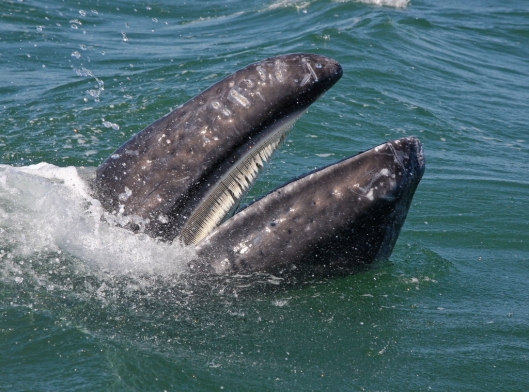
A baleen of a baby Gray whale (Eschrichtius robustus) sifts the krill from the sea water, 9 March 2008 / © Jo Crebbin @ Dreamstime (ID 13631684)
The gray whale has two blowholes near top of its head, which help the animal to exhale at the surface of the water. It can dive for up to 30 minutes and go 155 m (500 ft) deep. Between the deep dives it takes deep breaths for about 3–5 minutes. At rest, it spouts 2–3 times per minute – spouting creates a distinctive V- or heart-shaped blow – low and bushy, up to 3–4 m (9.8–13.1 ft) in height – that can be heard a mile away!
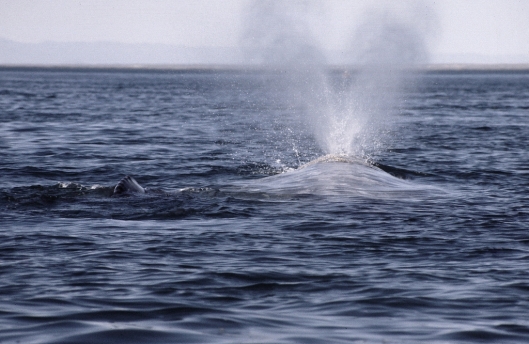
Gray whale (Eschrichtius robustus) blowing with its calf by side / Dr Steven Swartz @ NOAA: NOAA’s Ark – Animal Collection (ID anim1716)
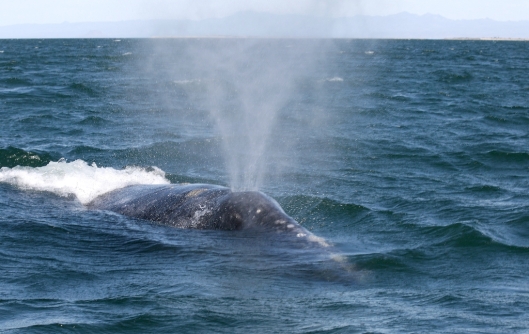
Gray whale (Eschrichtius robustus) blowing / Dr Steven Swartz @ NOAA: NOAA’s Ark – Animal Collection (ID anim1722)
The gray whale has no dorsal fin on its back, only a small hump, followed by a series of 8–14 small bumps, known as ‘knuckles’, positioned two-third of the way from the head and leading to the tail. The species has two broad flippers (pectoral fins) – each 1.2–1.5 m (4–5 ft) long – located behind and below the eyes. The flippers help the animal steer, turn and balance.
The whale’s tail consists of two lobes – each known as a fluke – separated by a deep notch, a V-shaped indentation, in the middle where the two meet. The tail measures about 3.6 m (12 ft) across and weighs 136–180 kg (300–400 lb). The flukes are used for propulsion – they are set horizontally on the body and move up and down to propel the whale through the water, unlike fish, which have vertical tails that move left and right. Unique speckled flukes make it easy for scientists to identify each individual.
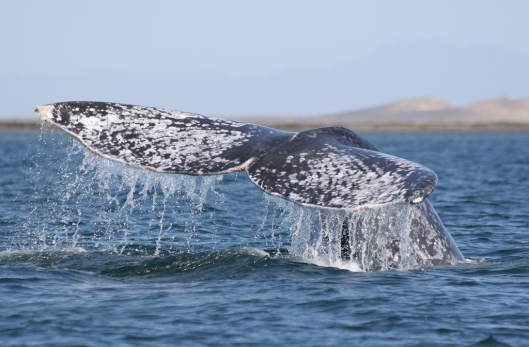
Speckled flukes (above) of a gray whale (Eschrichtius robustus) / Dr Steven Swartz @ NOAA: NOAA’s Ark – Animal Collection (ID anim1728)
2. By Surface Behaviour: Travelling and Stationary
A number of different kind of surface behaviour can be observed, when gray whales come to the surface to breathe – from travelling (e.g. breaching) to stationary (e.g. spyhopping and lobtailing) [for a full list, see Wikipedia]. Gray whales are very unobtrusive at the surface – they are sometimes referred to as ‘breathing rocks’ [Wild Whales]. In addition to respiration, cetaceans have developed and used surface behaviours for many other functions such as display, feeding and communication.
BREACHING is a leap out of the water. It is described by two techniques. First, when the whale (most commonly sperm and humpback whales) swims vertically upwards from depth and heads straight out of the water. Second, when the whale (including the gray whale) travels close to the surface and parallel to it and then jerks upwards at full speed with as few as 3 tail strokes to perform a breach [Wikipedia]. The gray whale jumps only partially out of the water and then falls back in at an angle. Many researchers have suggested that breaching is a behaviour used by whales to remove parasites, such as barnacles and whale lice, from their skin. But, as observed by Keith E Jones [Gray Whale], this is unlikely – first, lagoons are very shallow, and second, adults are too heavy and would be a huge expenditure of their energy. Jones, who have spent years of observing the gray whale, says that only juveniles (1–4 years old) are able to propel out of water, as well as mothers while teaching their babies during their brief instruction period – around mid Feb. While young jump as a form of play, because of their excitement or making them feel good, a breach is, nonetheless, a sign that the animal is physically fit enough to afford energy for this acrobatic display, hence it could be used for ascertaining dominance, courting or warning of danger [Wikipedia].
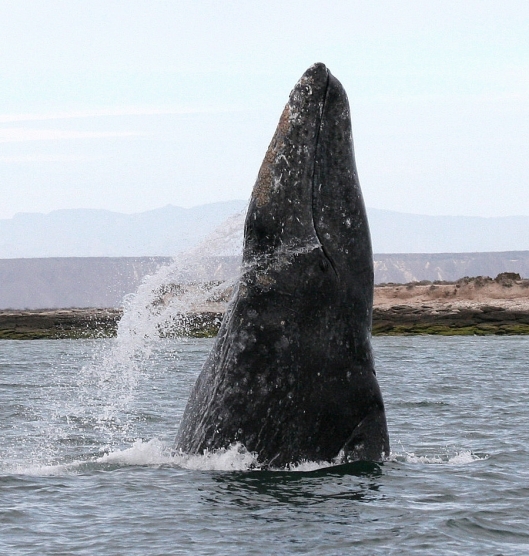
Gray whale (Eschrichtius robustus) breaching in a lagoon on the coast of Mexico, Mexico / Dr Steven Swartz @ NOAA: NOAA’s Ark – Animal Collection (ID anim1723)
SPYHOOPING is an act of a cetacean (including the gray whale) rising and holding a vertical position, while sticking its head up and partially out of the water. It can last for minutes at a time [Wikipedia], while the mammal is turning around to view the surroundings. Spyhooping is often performed in a social or play context. Most oceanographers believe that spyhooping allows gray whales get a better view of activity near the surface’s water – as their eyes often remain underwater, they think that such behaviour may have more to do with hearing than vision, as in that way the mammal can hear the waves near the surf line that marks its migration route. They have also observed that spyhopping occurs frequently when whales or dolphins interact with tourist boats – owing to their curiosity to find out what all the fuss is about at the surface, they stick their heads out of water [Dolphin Communication Project].
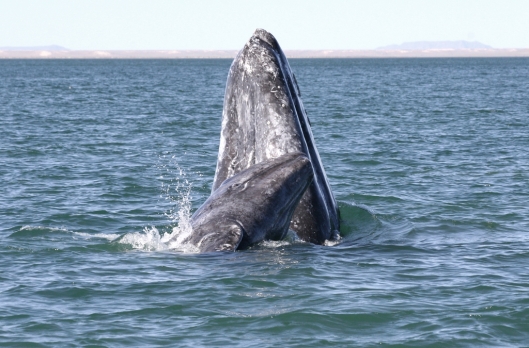
A mother gray whale (Eschrichtius robustus) spyhooping and its calf / Dr Steven Swartz @ NOAA: NOAA’s Ark – Animal Collection (ID anim1727)
LOPTAILING, also known as fluke or tail slapping, is an act of a cetacean (including the gray whale) lifting its fluke out of the water before the dive, and then smacking it against the surface hard and fast in order to make a big splash and a loud slapping sound. Unlike dolphins, who tend to remain horizontal and perform flipper slapping, gray whales tend to lobtail by positioning themselves vertically downwards into the water and then slapping the surface by bending the tail. All species are likely to slap several times in a single session time [Wikipedia]. This form of behaviour may serve both to communicate an internal state of aggression or annoyance, as well as to herd and stun fish during foraging.
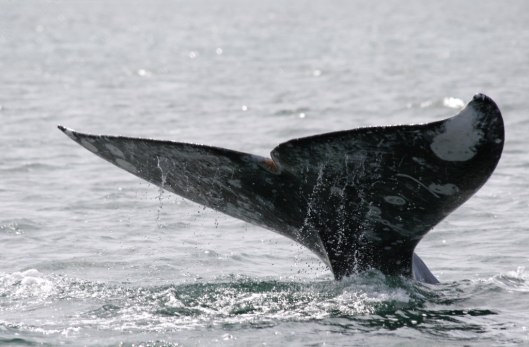
Flukes (below) of a gray whale (Eschrichtius robustus) / Dr Steven Swartz @ NOAA: NOAA’s Ark – Animal Collection (ID anim1721)
Other Wildlife
The bay and the lagoons, as well as the nearby mangrove swamps and forests, provide ecosystems and natural habitat for threatened and endangered wildlife. They also serve as a home to other marine mammals, such as blue whale (Balaenoptera musculus), California sea-lion (Zalophus californianus), northern elephant seal (Mirounga angustirostris) and harbour seal (Phoca vitulina). The shallow waters are, furthermore, an ideal habitat for four endangered species of marine turtles – leatherback sea turtle (Dermochelys coriacea), hawksbill sea turtle (Eretmochelys imbricata), green sea turtle (Chelonia mydas) and olive ridley sea turtle (Lepidochelys olivacea). And, there are also countless breeding and migratory bird species to be observed.
Bibliography
1. Caryl-Sue. 2012. “Gray Whale Spyhop.” National Geography Society. 29 Feb 2012. Article [Accessed 23 Jan 2017].
2. DCP Editorial. 2014. “What is spyhooping.” Dolphin Communication Project. 21 Oct 2014. Article [Accessed 23 Jan 2017].
3. Jones, Keith E.. 2012. “Why Do Gray Whale Jump.” Extract from Gray Whales: My Twenty Years of Discovery. Gray Whale. 2012. Article [Accessed 26 Jan 2017].
4. NOAA Editorial. 2013. “Gray Whale (Eschrichtius robustus).” NOAA Fisheries. 13 May 2013. Article [Accessed 23 Jun 2018].
5. Thomas. 2015. “Gray Whale Watching in Baja.” Baja Insider. 15 Jan 2015. Article [Accessed 23 Jan 2017].
6. Wild Whales Editorial. “Gray Whale (Eschrichtius robustus).” Wild Whales. Article [Accessed 26 Jan 2017].
Online resources for children
1. Editorial. “Gray Whale Facts.” Whale Facts. Article [Accessed 28 Jan 2017].
2. Southall, Brandon. 2005. “The Kids’ Times: Gray Whale.” NOAA’s National Marine Fisheries Service, Vol II, Issue 4, 2005:1–5. Article [Accessed 28 Jan 2017].
3. Various. 2004. “Marine Mammals: Gray Whale.” Kids do Ecology: NCEAS. 2004. Article [Accessed 28 Jan 2017].
4. Various. “Gray Whales.” Journey North (Annenberg Learner). A series of Articles [Accessed 28 Jan 2017].
